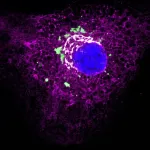(Press-News.org) In February, OpenAI released videos created by its generative artificial intelligence program Sora. The strikingly realistic content, produced via simple text prompts, is the latest breakthrough for companies demonstrating the capabilities of AI technology. It also raised concerns about generative AI’s potential to enable the creation of misleading and deceiving content on a massive scale. According to new research from Drexel University, current methods for detecting manipulated digital media will not be effective against AI-generated video; but a machine-learning approach could be the key to unmasking these synthetic creations.
In a paper accepted for presentation at the IEEE Computer Vision and Pattern Recognition Conference in June, researchers from Multimedia and Information Security Lab in Drexel’s College of Engineering explained that while existing synthetic image detection technology has failed thus far at spotting AI-generated video, they’ve had success with a machine learning algorithm that can be trained to extract and recognize digital “fingerprints” of many different video generators, such as Stable Video Diffusion, Video-Crafter and Cog-Video. Additionally, they have shown that this algorithm can learn to detect new AI generators after studying just a few examples of their videos.
“It’s more than a bit unnerving that this video technology could be released before there is a good system for detecting fakes created by bad actors,” said Matthew Stamm, PhD, an associate professor in Drexel’s College of Engineering and director of the MISL. “Responsible companies will do their best to embed identifiers and watermarks, but once the technology is publicly available, people who want to use it for deception will find a way. That’s why we’re working to stay ahead of them by developing the technology to identify synthetic videos from patterns and traits that are endemic to the media.”
Deepfake Detectives
Stamm’s lab has been active in efforts to flag digitally manipulated images and videos for more than a decade, but the group has been particularly busy in the last year, as editing technology is being used to spread political misinformation.
Until recently, these manipulations have been the product of photo and video editing programs that add, remove or shift pixels; or slow, speed up or clip out video frames. Each of these edits leaves a unique digital breadcrumb trail and Stamm’s lab has developed a suite of tools calibrated to find and follow them.
The lab’s tools use a sophisticated machine learning program called a constrained neural network. This algorithm can learn, in ways similar to the human brain, what is “normal” and what is “unusual” at the sub-pixel level of images and videos, rather than searching for specific predetermined identifiers of manipulation from the outset. This makes the program adept at both identifying deepfakes from known sources, as well as spotting those created by a previously unknown program.
The neural network is typically trained on hundreds or thousands of examples to get a very good feel for the difference between unedited media and something that has been manipulated — this can be anything from variation between adjacent pixels, to the order of spacing of frames in a video, to the size and compression of the files themselves.
A New Challenge
“When you make an image, the physical and algorithmic processing in your camera introduces relationships between various pixel values that are very different than the pixel values if you photoshop or AI-generate an image,” Stamm said. “But recently we’ve seen text-to video generators, like Sora, that can make some pretty impressive videos. And those pose a completely new challenge because they have not been produced by a camera or photoshopped.”
Last year a campaign ad circulating in support of Florida Gov. Ron DeSantis appeared to show former President Donald Trump embracing and kissing Antony Fauci was the first to use generative-AI technology. This means the video was not edited or spliced together from others, rather it was created whole-cloth by an AI program.
And if there is no editing, Stamm notes, then the standard clues do not exist — which poses a unique problem for detection.
“Until now, forensic detection programs have been effective against edited videos by simply treating them as a series of images and applying the same detection process,” Stamm said. “But with AI-generated video, there is no evidence of image manipulation frame-to-frame, so for a detection program to be effective it will need to be able to identify new traces left behind by the way generative-AI programs construct their videos.”
In the study, the team tested 11 publicly available synthetic image detectors. Each of these programs was highly effective — at least 90% accuracy — at identifying manipulated images. But their performance dropped by 20-30% when faced with discerning videos created by publicly available AI-generators, Luma, VideoCrafter-v1, CogVideo and Stable Diffusion Video.
“These results clearly show that synthetic image detectors experience substantial difficulty detecting synthetic videos,” they wrote. “This finding holds consistent across multiple different detector architectures, as well as when detectors are pretrained by others or retrained using our dataset.”
A Trusted Approach
The team speculated that convolutional neural network-based detectors, like its MISLnet algorithm, could be successful against synthetic video because the program is designed to constantly shift its learning as it encounters new examples. By doing this, it’s possible to recognize new forensic traces as they evolve. Over the last several years, the team has demonstrated MISLnet’s acuity at spotting images that had been manipulated using new editing programs, including AI tools — so testing it against synthetic video was a natural step.
“We’ve used CNN algorithms to detect manipulated images and video and audio deepfakes with reliable success,” said Tai D. Nguyen, a doctoral student in MISL, who was a coauthor of the paper. “Due to their ability to adapt with small amounts of new information we thought they could be an effective solution for identifying AI-generated synthetic videos as well.”
For the test, the group trained eight CNN detectors, including MISLnet, with the same test dataset used to train the image detectors, which including real videos and AI-generated videos produced by the four publicly available programs. Then they tested the program against a set of videos that included a number created by generative AI programs that are not yet publicly available: Sora, Pika and VideoCrafter-v2.
By analyzing a small portion — a patch — from a single frame from each video, the CNN detectors were able to learn what a synthetic video looks like at a granular level and apply that knowledge to the new set of videos. Each program was more than 93% effective at identify the synthetic videos, with MISLnet performing the best, at 98.3%.
The programs were slightly more effective when conducting an analysis of the entire video, by pulling out a random sampling of a few dozen patches from various frames of the video and using those as a mini training set to learn the characteristics of the new video. Using a set of 80 patches, the programs were between 95-98% accurate.
With a bit of additional training, the programs were also more than 90% accurate at identifying the program that was used to create the videos, which the team suggests is because of the unique, proprietary approach each program uses to produce a video.
“Videos are generated using a wide variety of strategies and generator architectures,” the researchers wrote. “Since each technique imparts significant traces, this makes it much easier for networks to accurately discriminate between each generator.”
A Quick Study
While the programs struggled when faced with the challenge of detecting a completely new generator without previously being exposed to at least a small amount of video from it, with a small amount of fine tuning MISLnet could quickly learn to make the identification at 98% accuracy. This strategy, called “few-shot learning” is an important capability because new AI technology is being created every day, so detection programs must be agile enough to adapt with minimal training.
“We’ve already seen AI-generated video being used to create misinformation,” Stamm said. “As these programs become more ubiquitous and easier to use, we can reasonably expect to be inundated with synthetic videos. While detection programs shouldn’t be the only line of defense against misinformation — information literacy efforts are key — having the technological ability to verify the authenticity of digital media is certainly an important step.”
END
On the trail of deepfakes, Drexel researchers identify ‘fingerprints’ of AI-generated video
Machine-learning approach could be key to mitigating AI-driven misinformation
2024-04-24
ELSE PRESS RELEASES FROM THIS DATE:
Virtual reality can motivate people to donate to refugee crises regardless of politics
2024-04-24
PULLMAN, Wash. – Political conservatives who watched a documentary on Syrian refugees with a virtual reality headset had far more sympathy for the people depicted in the film than those who viewed the same film on a two-dimensional computer screen.
Higher sympathy levels among the conservatives who watched the VR version of the documentary, “Clouds over Sidra,” resulted in a greater willingness to donate to the crisis, according to a study on the research published in New Media & Society.
Liberal participants in the study reported high levels of sympathy and ...
Holographic displays offer a glimpse into an immersive future
2024-04-24
Setting the stage for a new era of immersive displays, researchers are one step closer to mixing the real and virtual worlds in an ordinary pair of eyeglasses using high-definition 3D holographic images, according to a study led by Princeton University researchers.
Holographic images have real depth because they are three dimensional, whereas monitors merely simulate depth on a 2D screen. Because we see in three dimensions, holographic images could be integrated seamlessly into our normal view of the everyday world.
The result is a virtual and augmented reality display that has the potential to be truly immersive, the kind where you can move your head ...
Novel Au-BiFeO3 nanostructures for efficient and sustainable degradation of pollutants
2024-04-24
The need for sustainable and environment-friendly solutions has accelerated the global demand for green and renewable technologies. In this regard, semiconductor photocatalysts have emerged as an attractive solution, owing to their potential in mitigating pollutants and harnessing solar energy efficiently. Photocatalysts are materials that initiate chemical reactions when exposed to light. Despite their progress, commonly used photocatalysts suffer from reduced photocatalytic activity and a narrow operation range within the visible ...
It takes two to TANGO: New strategy to tackle fibrosis and scarring
2024-04-24
Researchers at the Centre for Genomic Regulation in Barcelona and the University of Cologne in Germany have developed a new experimental strategy to tackle scarring and fibrosis. Experiments with patient-derived human cells and animal models showed the strategy was effective, non-toxic and its effects reversible. The findings are published today in the journal Nature Communications.
Scarring occurs from the secretion and accumulation of various components – primarily proteins known as collagens – into the space between individual cells, usually occurring as a response to injury or damage. Excessive collagen secretion can also cause the buildup of fibrotic ...
Researchers aim to analyze pangenomes using quantum computing
2024-04-24
A new collaboration brings together a world-leading interdisciplinary team with skills across quantum computing, genomics, and advanced algorithms. They aim to tackle one of the most challenging computational problems in genomic science: building, augmenting and analysing pangenomic datasets for large population samples. Their project sits at frontiers of research in both biomedical science and quantum computing.
The project, which involves researchers based at the University of Cambridge, the Wellcome Sanger Institute and EMBL’s European ...
Ready and vigilant: immune cells on standby
2024-04-24
When pathogens invade the body, the immune system must react immediately to prevent or contain an infection. But how do our defence cells stay ready when no attacker is in sight? Scientists from Vienna have found a surprising explanation: They are constantly stimulated by healthy tissue. This keeps them active and ready to respond to pathogens. Based on this insight, future medications could be devised to selectively enhance our immune system’s attention. The study has been published in the journal Nature Immunology (DOI: 10.1038/s41590-024-01804-1).
Communication is crucial in immune defence. When ...
Securing competitiveness of energy-intensive industries through relocation: The pulling power of renewables
2024-04-24
“Our new study shows that renewable-scarce countries like parts of the EU, Japan and South Korea could save between 18 to 38 percent in production costs”, explains Philipp Verpoort, scientist at the Potsdam Institute for Climate Impact Research (PIK) and lead author of the study published in Nature Energy. “They could do so by relocating their production of industrial basic materials like green steel and chemicals based on green hydrogen to countries where renewable energy is cheap.” The use of renewable electricity and green hydrogen is ...
CAR T cell therapy targeting HER2 antigen shows promise against advanced sarcoma in phase I trial
2024-04-24
HOUSTON – (April 24, 2024) – Researchers at Texas Children’s Cancer Center and the Center for Cell and Gene Therapy at Baylor College of Medicine, Texas Children’s Hospital and Houston Methodist published results of a phase I clinical trial of a novel immunotherapy for high-risk sarcomas in the journal Nature Cancer.
The therapy uses chimeric antigen receptor (CAR) T cells engineered to target the HER2 protein, which is overexpressed on the surface of sarcoma cells. The HEROS 2.0 trial showed that this therapeutic approach is safe and is associated with clinical benefit.
“CAR T cell therapy has been a highly successful strategy for recurrent ...
Social change may explain decline in genetic diversity of the Y chromosome at the end of the Neolithic period
2024-04-24
The emergence in the Neolithic of patrilineal1 social systems, in which children are affiliated with their father's lineage, may explain a spectacular decline in the genetic diversity of the Y chromosome2 observed worldwide between 3,000 and 5,000 years ago. In a study to be published on 24 April in Nature Communications, a team of scientists from the CNRS, MNHN and Université Paris Cité3 suggest that these patrilineal organisations had a greater impact on the Y chromosome than mortality during conflict.
This ...
Aston University research finds that social media can be used to increase fruit and vegetable intake in young people
2024-04-24
The research team asked one group of participants to follow healthy eating accounts and another to follow interior design accounts
After just two weeks, participants following healthy eating accounts ate more fruit and vegetables and less junk food
Even minor tweaks to social media accounts could result in substantial diet improvements in young adults.
Researchers from Aston University have found that people following healthy eating accounts on social media for as little as two weeks ate more fruit and vegetables and less junk food.
Previous ...
LAST 30 PRESS RELEASES:
Review article | Towards a Global Ground-Based Earth Observatory (GGBEO): Leveraging existing systems and networks
Penn and UMich create world’s smallest programmable, autonomous robots
Cleveland researchers launch first major study to address ‘hidden performance killer’ in athletes
To connect across politics, try saying what you oppose
Modulating key interaction prevents virus from entering cells
Project explores barriers to NHS career progression facing international medical graduates
Jeonbuk National University researchers explore the impact of different seasonings on the flavor perception of Doenjang soup
Two Keck Medicine of USC Hospitals named Leapfrog Top Teaching Hospitals
World-first discovery uncovers how glioblastoma tumours dodge chemotherapy, potentially opening the door to new treatments
A fatal mix-up: How certain gut bacteria drive multiple sclerosis
New AI tool identifies not just genetic mutations, but the diseases they may cause
Deep-learning model predicts how fruit flies form, cell by cell
Combination pills for high blood pressure may simplify treatment, improve long-term health
Immune system keeps mucosal fungi in check
Neurons within the brain use simple rules to localize genetic messages
Electrodes created using light
Second-hand gift-giving is a well-deliberated decision
How human interaction drove evolution to make bears less aggressive
National Poll: Few parents offer teens guidance on healthy eating during holiday season
Cannabis derivatives could provide new ovarian cancer treatments
Raising strong yeast as a petroleum substitute
Clues to the origin of hot Jupiters hidden in their orbits
Canada’s reduced pledge to Global Fund will impact domestic health
1 in 4 children with major traumatic injuries not cared for in pediatric trauma centres
Duke and Duke-NUS’ joint cross-population research to uncover "East-West" differences in disease and care
Scientists to ‘spy’ on cancer- immune cell interactions using quantum technology breakthrough
Tech savvy users have most digital concerns
Making lighter work of calculating fluid and heat flow
Normalizing blood sugar can halve heart attack risk
Lowering blood sugar cuts heart attack risk in people with prediabetes
[Press-News.org] On the trail of deepfakes, Drexel researchers identify ‘fingerprints’ of AI-generated videoMachine-learning approach could be key to mitigating AI-driven misinformation




